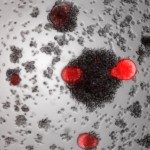Link to Pubmed [PMID] – 19019958
J. Virol. 2009 Feb;83(3):1289-98
The glycine-alanine repeat (GAr) sequence of the Epstein-Barr virus-encoded EBNA-1 prevents presentation of antigenic peptides to major histocompatibility complex class I molecules. This has been attributed to its capacity to suppress mRNA translation in cis. However, the underlying mechanism of this function remains largely unknown. Here, we have further investigated the effect of the GAr as a regulator of mRNA translation. Introduction of silent mutations in each codon of a 30-amino-acid GAr sequence does not significantly affect the translation-inhibitory capacity, whereas minimal alterations in the amino acid composition have strong effects, which underscores the observation that the amino acid sequence and not the mRNA sequence mediates GAr-dependent translation suppression. The capacity of the GAr to repress translation is dose and position dependent and leads to a relative accumulation of preinitiation complexes on the mRNA. Taken together with the surprising observation that fusion of the 5′ untranslated region (UTR) of the c-myc mRNA to the 5′ UTR of GAr-carrying mRNAs specifically inactivates the effect of the GAr, these results indicate that the GAr targets components of the translation initiation process. We propose a model in which the nascent GAr peptide delays the assembly of the initiation complex on its own mRNA.

